Subtitled “Life support for the nation’s circulatory system”, the 1994 book Infra Structures by Malcolm Wells offers a chance to revisit the integration of our architecture and infrastructural systems – appropriate for our new found interest in the workings of our society and urbanity. The the juxtaposed pipe/greenery on the cover, the thrust of this book is quite specific from the get-go.

:: image via Malcolm Wells
Wells has a cult following as a purveyor of early ecological design, particularly his notable installations and visuals of underground architecture. The interesting thing about the book is not so much another treatise regarding massive projects and the myriad ways architecture can influence these, but rather how they MUST exert influence to infrastructure in a positive way. The separation of the word into the separates of ‘infra’ (below) and ‘structure’ (something constructed) alludes to this architectural dualism.
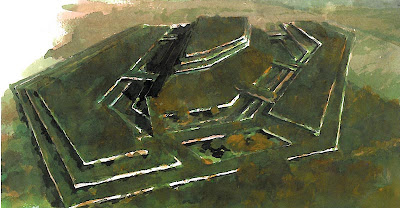
:: Subterranean Shopping Mall – image via Infra Structures
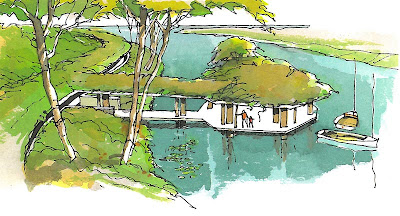
:: green covered boat house – image via Infra Structures
The ‘story’, if you will, leads us on a tour of future buildings and structures that exist in the not-too-distant-future, strangely enough more a contemporary vision of the early 21st Century. Based on the preponderance of veg.itecture in the world, Wells may have been somewhat prophetic (p.23):
“… I hesitate to make any but the most general of predictions for even the next 50 years. With everyting changing at an ever-faster rate it would be silly to stick my neck out too far. The only thing to do is try to make our buildings adaptable to greatly changed, rapidly changing occupancies. … Animals and plants will continue to need the out-of-doors in life on earth to be sustained. That means underground architecture for the human species.”
Although the words aren’t half bad, my favorite aspect of Wells’ book is the visuals – a throwback to an era that could’ve existed anywhere between the 1960s and today – but with a simple pen/ink/watercolor combo that is both illustrative and evocative. While some may bristle at the dated ‘look’ of the graphics, they are successful in their goal – communicate intent, form, and materials. Call it graphics for veg.itectural non-form. A common theme is ubiquitous infrastructure – such as the highway… snaking through virtually everywhere, the linear path that severs can be re-imagined into habitat corridors and earth sheltered bridges.
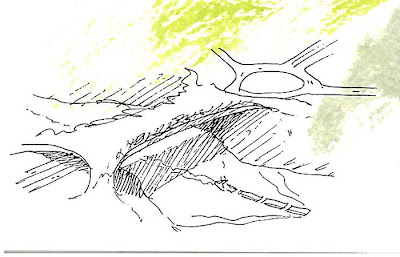
:: land bridge – images via Infra Structures
The books’ author offers some fun with the text, resorting to comic-book like thought bubbles to illustrate the point, as below (p.21): “It would be nice if animals – as well as plants – could make use of the land-to-land connection bridges offer human travelers. And the all-weather aspect of covered roadways does have a lot of appeal… But an earth-covered bridge? Come on. Next thing you know he’ll be proposing underground airports.”
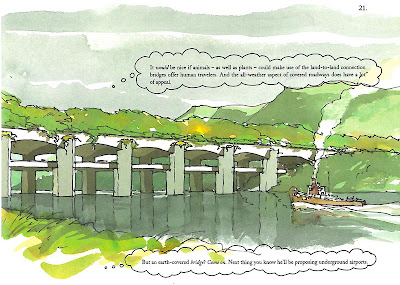
:: elements of graphic novel – image via Infra Structures
And there is plenty of infrastructure, including highways, bridges, wastewater treatment, sports stadiums, and the aforementioned underground airport… looking much like a storyboard from The Empire Strikes Back zooming over the mood of Endor.

:: ferry terminal with under greenery parking
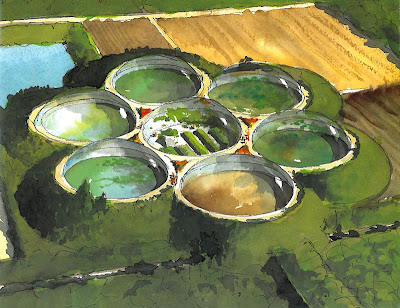
:: city-scale living machine for waste treatment – images via Infra Structures
So what can we learn from looking back at some of the work and visuals of Malcolm Wells? While again we can see the vision of this man who looked at infrastructure as both a design problem and environmental solution – leading the way to what could literally be the emergence of figuratively and literally green architecture. Perhaps it’s a nudge to pull out your sketchbook and envision a reality beyond what’s sitting on your desk, in your computer, or outside your window, but what could be. Finally, it’s a call to arms for architecture (and more broadly the allied arts) to be part of the solution, not part of the problem. From Infra Structures, p. 29:
“What a structure does, that is, how it acts upon the world around it, is far more important that how it looks. That would seem to go without saying, but it appears never to have concerned those of us who have built over our rich America land. …If a building, a bridge, a dock, or a road destroys land, it’s simply not doing its job. A handsome structure that kills land is an enemy, and we are only now slowly coming to realize it. If, on the other hand, the structure is kind to the land, chances are that it will be its very appropriateness be both appealing and beautiful.”
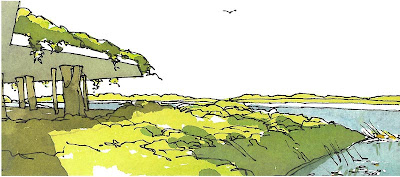
:: image via Infra Structures


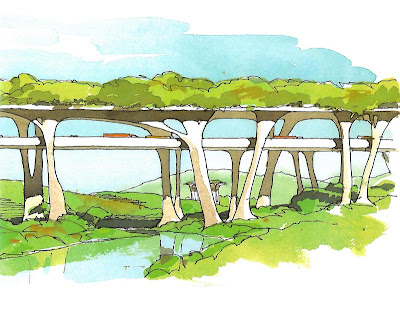

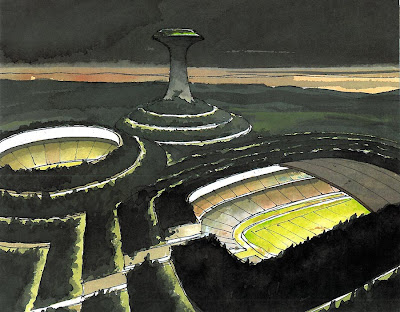
That is some pretty neat, green concepts. Effectively proposes creating a new skin for the Earth. I mean if all human built objects/structures are covered like this..